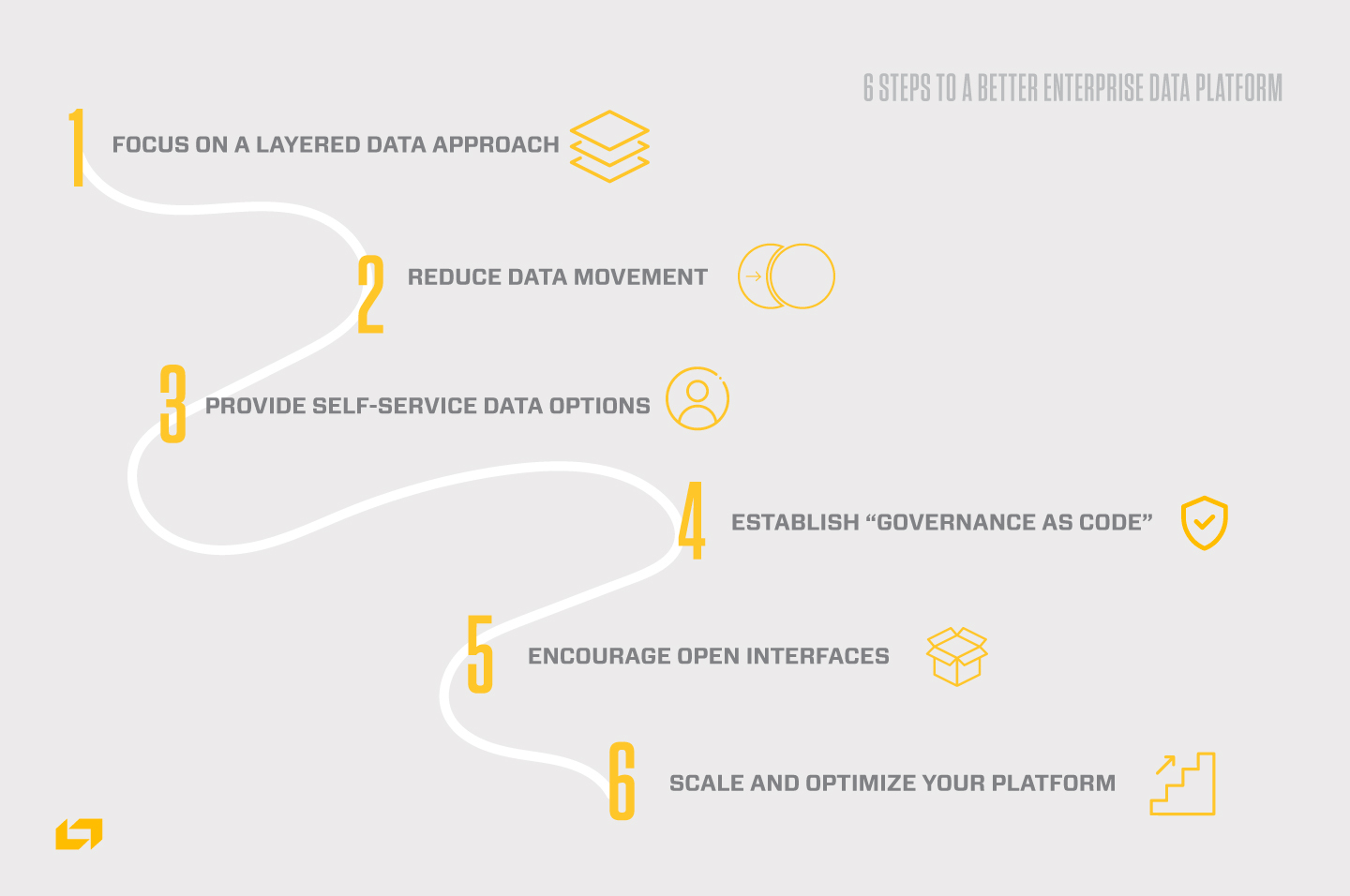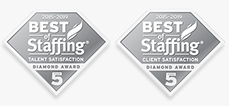By Nate Bruce, Chris Lundeberg, and Jake Gower | Technology Partners
Purchasing a world-class data management platform without a complementary strategy is like buying a Ferrari but keeping it in neutral.
This form of enterprise buyer’s remorse is more prevalent than you may think.
In partnering with Microsoft and Databricks, our Cloud, Data & AI practice has helped solve major data platform challenges within some of the country’s largest enterprises and medical research institutions.
Building a highly effective data platform strategy that delivers on modern data and artificial intelligence needs isn’t easy. But it is a necessity.
Here are the six steps we’ve established based on insights from our highly entrepreneurial team and experience serving our clients.
Step 1: Focus on a Layered Data Approach
Step 2: Reduce Data Movement
Step 3: Provide Self-Service Data Options
Step 4: Establish “Governance as Code”
Step 5: Encourage Open Interfaces
Step 6: Scale and Optimize Your Platform

Read on to dig into each one to help your organization start thinking differently about your overall data platform strategy.
Defining the Issue
We see it across the map right now in businesses spanning multiple industries. Leaders understand that data is key to their operation, but they are stuck when it comes to building an effective, comprehensive enterprise data strategy.
Why? Because doing so takes all of the most difficult parts of data management and rolls them into one. A great data strategy requires building the best cloud strategy, resolving the most complex data governance challenges, and then weaving in the details that will make the data both accessible and actionable.
Scalability isn’t enough. To meet the needs of an organization, it’s all about security, cost management, data governance-as-code, and enabling analysis at scale to truly deliver data-as-a-service in a secure and meaningful way.
At Technology Partners, we walk clients through these steps to success:
Step 1: Focus on a Layered Data Approach
Are you employing dozens of data scientists to seemingly clean data all day long? You can benefit from data layering.
Data layers are key in displaying information from feature services, organizing insights through specific queries, and providing business users access to critical attributes. You can use different types of data layers to access and display varying types of data in your applications. The functionality of each layer is dependent on your overall strategy.
Step 2: Reduce Data Movement
There’s really no point in building an expansive, costly, scalable data platform that centralizes your key insights if you’re still manually moving data and compromising data reliability, lineage, provenance, and visibility.
If data is moving, it’s at risk.
In our experience a data lakehouse, which leverages the best of both data lake and data warehouse characteristics, is the smartest path forward. Layering cloud data lakes with delta technology enables best in class outcomes for business intelligence and AI/ML.
To save costs, prevent data silos, and avoid operational headaches, data should always be accessible via enterprise data sharing tools. This keeps information flowing between teams, partners, and suppliers, if needed.

Step 3: Provide Self-Service Data Options
Why is my specific product trending up? Did our recent promotion have an impact? Should we adjust pricing to take advantage of these insights?
Without self-service data options for your team, you’ll find yourself stuck in the mud.
Your data strategy must allow for self-discovery. Instead of relying on a technology team and arduous data request processes, today’s businesses need near real-time access to data.
In a perfect world, every business unit can derive its decisions by analyzing its own centrally provided insights. A great data strategy can achieve this.
Step 4: Establish “Governance as Code”
We have seen organizations spend many years and millions of dollars building what they thought was an effective data governance strategy. Yet instead of successfully creating a data-first culture, they end up even more in flux than where they started.
Complicated data governance policies will never be a replacement for meaningful reports and models driven by high-quality data.
Our tooling and the metadata monitoring that we have built, implemented, and integrated is transforming organizations across the country. And our clients have column- and row-level access control to their data. This is key as the data lakehouse grows and processes adjust within an expanding organization.
Step 5: Encourage Open Interfaces
Open interfaces are the primary drivers of interoperability. We enable our clients to utilize Delta, an open-source technology, to take advantage of open interfaces.
Essentially, we function as a partner tool, so organizations don’t have to build everything on their own. This leads to obvious cost savings and allows for first-to-market success for your most innovative business ideas, products, and services.
Open interfaces help not only with speed, but with longevity as well. Your data is more robust and portable with a flexible lakehouse platform that relies on open interfaces.
Step 6: Scale and Optimize Your Platform
To enable a business to perform the various workloads required for a successful operation, a scalable platform is necessary.
Some questions to consider:
• Do you have a strategy for lowering your data management costs as you scale?
• How will you automate new data sources in the future?
• How will you reduce labor-intensive heavy lifting in ETL, data cleansing, and visualization efforts?
A scaled-up, optimized data platform means less cost, better insights, and more control over your operational needs.
Where is your company in its data management journey?
Why Technology Partners Can Help
Our Data & Artificial Intelligence Practice at Technology Partners uses entrepreneurial curiosity and data-first ingenuity to solve high-value challenges for major organizations.
Our partners include Microsoft and Databricks, and our clients include multibillion-dollar enterprises and world-class academic medical centers.
How We Do It
Through service excellence and creative solution engineering, we deliver world-class, high-impact data platforms and data analysis capabilities.
• Talent – Unique balance of modern cloud skills with a history of solving high-value problems.
• Technology – Intense focus on enabling organizations to solve the hardest problems through delta lakehouse platforms and best-in-class analyses.
• Transformation – Prioritization of long-term growth via strategy, co-working, flexibility, outsourcing, product integration, and analysis at scale.
Success Stories
Sample clients and major outcomes through successful implementations of enterprise data platforms:
• Elite Academic Medical Center – Nationally recognized by Microsoft for advancing precision medicine, along with curriculum, finance, admin predictive analytics and insight delivery
• Elite Academic Medical Center (2) – Nationally recognized by Databricks for advancing national population health outcomes for clinical research efforts in the United States
• $3.5B Annual Revenue Enterprise – Enabled new financial analysis from visualizations to predictive analytics, surfacing first-of-their-kind insights in an automated fashion
• $1B Annual Revenue Grocer – Enabled precision insights at scale for hyper-personalization efforts to efficiently maximize revenue opportunities through data science
In addition, we are expanding our partnership with Databricks. This native platform was built from the ground-up to deliver all the required capabilities to make data teams efficient at delivering self-service data products. It combines the best features of data warehouses and data lakes as a single solution for all major data workloads.
Ready to build a world-class data strategy? Reach out today.




